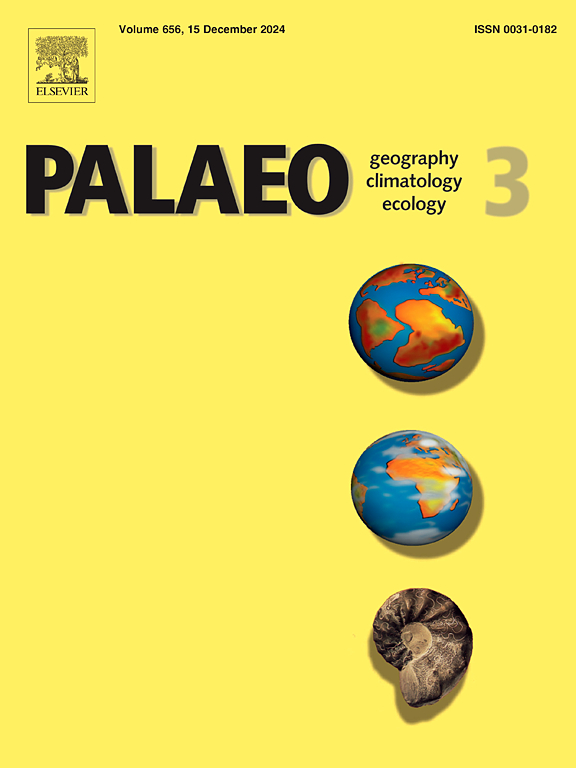意大利伦巴第盆地三叠系—侏罗系过渡时期碳酸盐相变化和碳同位素漂移:局部影响还是全球变化?
IF 2.7
2区 地球科学
Q2 GEOGRAPHY, PHYSICAL
Palaeogeography, Palaeoclimatology, Palaeoecology
Pub Date : 2025-05-30
DOI:10.1016/j.palaeo.2025.113061
引用次数: 0
摘要
全球气候、大气和海洋变化可能影响碳循环,并记录在海相碳酸盐、陆相和海相有机质沉积物的碳稳定同位素特征中。除了全球事件外,碳酸盐层序和富有机质沉积中记录的δ13C偏移可能是由多种局部因素引起的,掩盖或模拟了全球c旋回扰动。区分全球c旋回扰动或局部和区域沉积和环境因素对观测到的δ13C垂直趋势变化的贡献是理解沉积学和地球化学耦合研究的基础。为了深入研究这一问题,研究人员重新研究了伦巴第盆地(意大利南部阿尔卑斯山脉)三叠系-侏罗系的连续碳酸盐岩演替,研究了相组合的变化以及δ18O、δ13Ccarb、δ13Corg和C/N(原子)值的变化。三叠纪-侏罗纪的过渡见证了一系列全球环境扰动,导致了三叠纪末灭绝,这是由中大西洋岩浆省向大气中注入的火山二氧化碳引发的。除了Rhaetian生物群的消亡外,所研究的碳酸盐演替还以突然的相变化为标志:从由珊瑚、双壳类和有孔虫组成的泥灰岩-灰岩旋回(Zu Limestone)到层状钙泥岩-泥灰岩(Malanotte组)被前积的鲕状颗粒岩/包砾岩浅滩(Albenza组)覆盖。δ13Ccarb和δ18O值在Rhaetian-Hettangian海相碳酸盐岩的预期范围内,但δ13Corg和C/N曲线之间的关系表明可能受到陆相与海相有机质比例变化的影响。垂向相叠加与δ18O、δ13Ccarb、δ13Corg值和C/N比值的整合在三个研究序列中是一致的,为全球碳旋回扰动提供了可能的解释。δ13Corg值的变化(在±1‰范围内)可以解释为与不同(陆相与海相)有机质类型相关的硅屑供应的变化。本文章由计算机程序翻译,如有差异,请以英文原文为准。
Carbonate facies changes and Carbon isotope excursions across the Triassic-Jurassic transition (Lombardy Basin, Italy): Local effects or global changes?
Global climatic, atmospheric and oceanographic changes may affect the Carbon cycle and be recorded in the C stable isotope signature of marine carbonate and terrestrial and marine organic matter deposits. Besides global events, δ13C excursions recorded in carbonate successions and organic matter-rich deposits may result from diverse local factors, masking or mimicking global C-cycle perturbations. Distinguishing the contribution of global C-cycle perturbations or local and regional sedimentary and environmental factors to the observed changes in the δ13C vertical trends is fundamental for the understanding of coupled sedimentological and geochemical studies. To delve into this issue, a previously well-studied, continuous carbonate succession across the Triassic-Jurassic transition in the Lombardy Basin (Southern Alps, N Italy) has been revisited investigating changes in facies association and variations of δ18O, δ13Ccarb, δ13Corg and C/N (atomic) values. The Triassic-Jurassic transition witnessed a cascade of global environmental perturbations responsible for the End Triassic Extinction, triggered by the injection of volcanic CO2 in the atmosphere from the Central Atlantic Magmatic Province. Besides the demise of Rhaetian biota, the studied carbonate succession is marked by abrupt facies changes: from marlstone-limestone cyclothems with corals, bivalves and foraminifers (Zu Limestone) to laminated calci-mudstone and marlstone (Malanotte Formation) overlain by progradational ooidal grainstone/packstone shoals (Albenza Formation). The δ13Ccarb and δ18O values are within those expected from Rhaetian-Hettangian marine carbonates, but relationships between the δ13Corg and C/N curves suggest a possible influence by changes in the ratio of terrestrial vs. marine organic matter. The integrations of vertical facies superposition with the δ18O, δ13Ccarb, δ13Corg values and C/N ratios are in tune in the three studied successions, suggesting possible alternative interpretations to global C-cycle perturbations. Changes in the δ13Corg values (in the range of ±1 ‰) may be explained by the variability of siliciclastic supply associated with different (terrestrial vs. marine) types of organic matter.
求助全文
通过发布文献求助,成功后即可免费获取论文全文。
去求助
来源期刊
CiteScore
5.90
自引率
10.00%
发文量
398
审稿时长
3.8 months
期刊介绍:
Palaeogeography, Palaeoclimatology, Palaeoecology is an international medium for the publication of high quality and multidisciplinary, original studies and comprehensive reviews in the field of palaeo-environmental geology. The journal aims at bringing together data with global implications from research in the many different disciplines involved in palaeo-environmental investigations.
By cutting across the boundaries of established sciences, it provides an interdisciplinary forum where issues of general interest can be discussed.

 求助内容:
求助内容: 应助结果提醒方式:
应助结果提醒方式:


